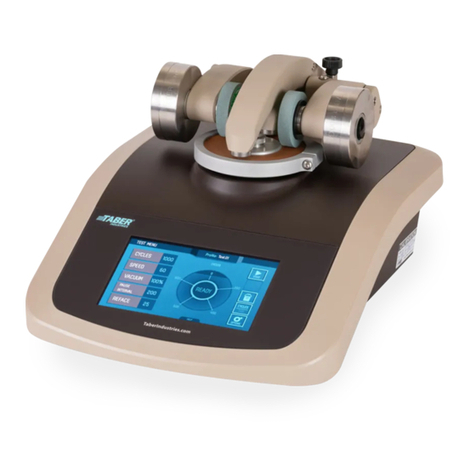SUGGESTION: For soft materials, it is recom-
mended to test within 3 seconds after lowering the
scratch pins onto the specimen surface.
•Mark the direction of movement of the
scratching device on the panels, taking care
not to mark the surface just tested.
•To remove the specimen, raise the spline-
shaft fingers using the handle and release the
clamping.
•Evaluate the extent of the damage on the
sample.
Speed Adjustment
Prior to conducting any tests, you will need to
adjust the speed of the platform. A sliding veloc-
ity of approximately 100mm per second (± 10) is
normally recommended.
•Turn the knob on the air regulator/lubricator to
an air pressure between 80 - 100 psi. To
increase air pressure, turn the knob clockwise
(to decrease turn counterclockwise).
•Using the handle, raise the 'fingers' to the
upright position.
•Press the red button to reset the electronic timer.
•Actuate the moveable platform by turning the
control knob in the direction the table will trav-
el. The number displayed on the timer, indi-
cates the time in seconds it takes the platform
to travel 100mm.
•To adjust platform speed, turn the flow control
valves found on the right hand side of the
instrument. Turning the valve counter-clock-
wise will increase the speed, while turning it
clockwise will decrease the speed. If you are
testing in both directions, ensure the platform
travels at the same rate. The valve toward
the front of the instrument controls the speed
when the platform is moving to the left. The
valve toward the back, controls the speed
when the platform is moving to the right.
•After adjusting the flow control valve, lock in
place by tightening the lock thumbnut.
•Lower the scratch (mar) tips onto a ‘dummy’ test
specimen, and verify the speed adjustment.
To calculate the platform speed, divide 100mm
by the time shown on the display
XWARNING: It is possible for the speed of
the platform to exceed the capacity of the
automatic Start/Stop of the electronic timer.
Should this occur, disconnect the timer and
operate electronic timer by hand using the
Green button to Start and Stop.
Weight Adjustment
If you are not following a test method that indi-
cates which weights are required, start with 3N,
5N, 7N, 10N, and 15N. Loads can be increased
or decreased accordingly.
CALCULATION OF RESULTS
Depending on the type of material under evalua-
tion, the visual appearance of a scratch normally
involves changes in surface topography, color, or
brightness. Three methods are normally used:
Method A - Visual Evaluation:
Using a controlled light source, hold the sample
such that the scratch lines are in a horizontal posi-
tion to the observer. The scratch line caused by
the highest weight should be at the upper position.
Rotate the sample, so the angle of observation
changes. The observer should be checking each
scratch line individually, and noting the point at
which the scratch lines emerge at the clearest vis-
ibility. Do not use the starting and ending point of
the scratch lines (approx. 10mm) in this evaluation.
Examine all scratch lines and rate according to a
Rating Scale 1 to 5 (1 = no scratch line at all; 5 =
severe scratch line). For plastic materials, indi-
cate if the line exhibits signs of whitening.
Report the tip diameter, stylus loading level, and
Rating Number for each line on the surface of the
sample.
SUGGESTION: A lightbooth with North Sky
Daylight (D65) has been recommend as a lighting
source for automotive specifications.
4 710 Operating Instructions ver 1.1




























